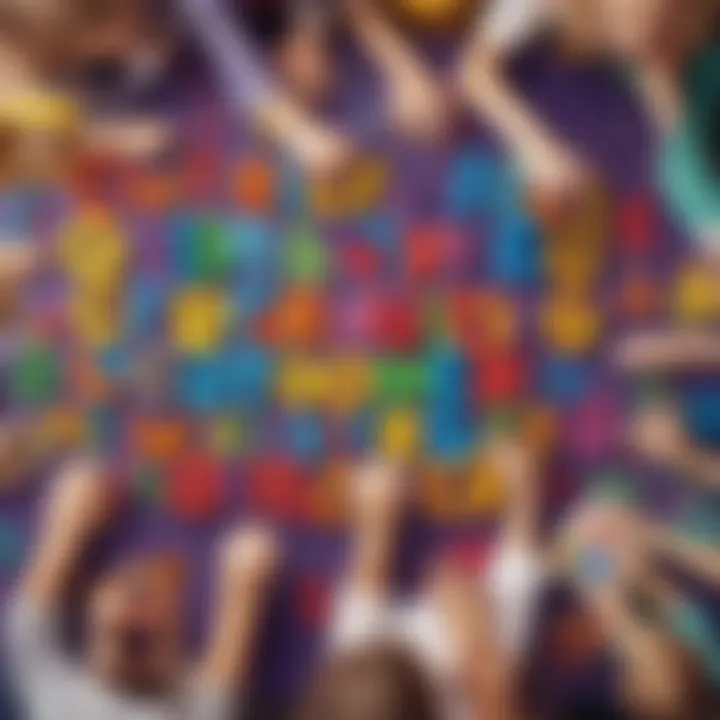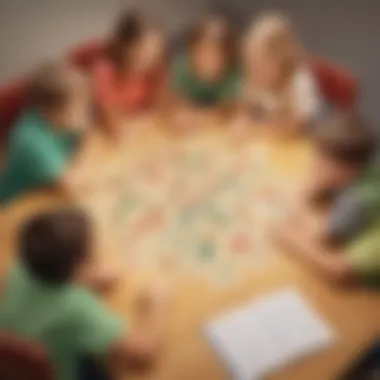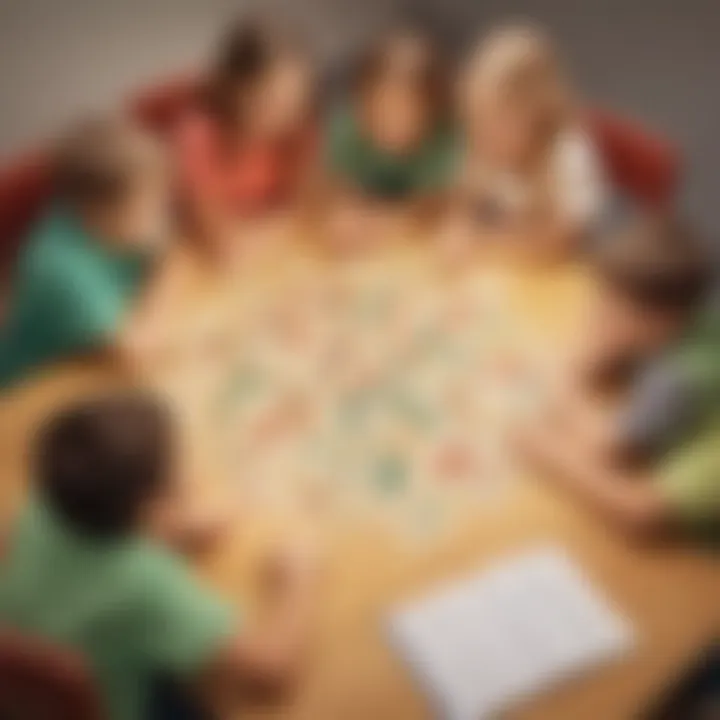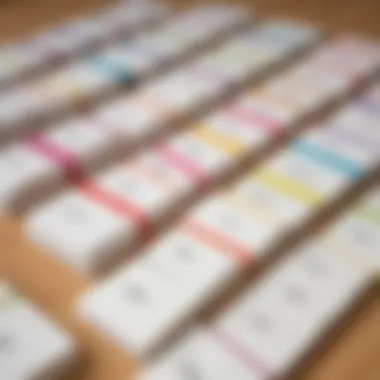Engaging Techniques for Enhancing Spelling Skills


Intro
Spelling is a fundamental skill for young learners, providing the building blocks for effective communication and literacy. Engaging children in creative and fun ways fosters a deeper understanding of spelling, making practice less tedious. This article outlines innovative techniques appropriate for different learning styles, reinforcing not only spelling proficiency but also overall cognitive skills.
Creative Activities
Involving students in hands-on activities makes learning more enjoyable. Creative activities not only stimulate interest but also provide avenues for better retention of spelling words.
Craft Ideas
Simple crafts can pinpoint specific words and their meanings or peculiarities. Here are some engaging ones:
- Letter Collage: Children cut letters from magazines or newspapers and glue them onto cardboard to form words.
- Spelling Banners: Use colorful paper to create banners displaying spelling words in the child's room, creating a visual reminder.
Step-by-Step Guides
- Letter Collage: Begin by gathering materials: scissors, an array of magazines, and glue.
- Next, select target words. Ask your child what words they find challenging.
- Search through magazines, snipping out letters, assisting with recognizing the shape of the letters closely.
- Finally, once the letters are gathered, help them arrange and stick these on the cardboard.
This crafty approach reinforces the child’s connection with letters and spelling in a fun and interactive manner.
Educational Value
Engaging in such creative activities promotes fine motor skills and language development. As children handle materials and create their projects, they also practice critical thinking to see the words come together visually.
Fun Quizzes
Quizzes can transform boring spelling drills into engaging challenges. Popular platforms like ElemFun offer tailored quizzes designed for students.
Quiz Topics
These quizzes cover extensive topics including:
- Common Spelling Rules
- Contextual Uses of Words
- Rhyming Words
Question Types
Quizzes use various question types to keep learners engaged, such as:
- Multiple choice questions
- Fill-in-the-blank
- Matching sections for words and definitions
Knowledge Reinforcement
These engaging quizzes help reinforce learning by providing immediate feedback. Every correct answer boosts confidence, while incorrect ones serve as a soft nudge toward understanding and improvement.
Fact-Based Articles
Fact-based articles help solidify foundational knowledge through informative reading that relates to spelling practice.
Topics
The articles may cover a variety of topics that include:
- The history of the English language
- Famous literary works
- Practical tips for daily spelling enhancement
Engaging Content
These articles present information clearly and engagingly, ensuring that even children find it accessible. Use pictures or graphs where relevant can assist in retention as well.
Understanding the Importance of Spelling
In today's world, effective communication holds significant weight across all scenarios. This section delves into the foundational role of spelling in facilitating clear message transmission. For young learners, spelling is not just a basic language skill; it is a fundamental aspect of their educational journey. Developing strong spelling skills transforms the ability to express thoughts accurately, leading to improved academic performance and confident interpersonal exchanges. Furthermore, spelling engages cognitive functions that are critical for overall language development.
The Role of Spelling in Communication
Spelling acts as the connective tissue in our ability to communicate. When written words are spelled correctly, they serve to express ideas while minimizing the chances of misunderstandings. For elementary school students, who often begin to form their vocal identities, strong spelling skills are vital. In everyday interaction, each misspelling could lead to confusion or misinterpretation of the intended meaning.
Young learners benefit immensely from grasping the significance of spelling in effective communication. Each correctly spelled word not only conveys meaning but also influences how others perceive the writer. Ultimately, good spelling habits foster clearer interactions and promote a better understanding between individuals both in academic settings and social situations.
Spelling and Cognitive Development
The cognitive processes associated with learning to spell are intricate and extensive. Mastery of spelling develops more than just the mechanics of writing. It enhances language comprehension and enriches vocabulary through various spelling strategies that young learners can adopt. Learning spelling also exercises memory and strengthens neural connections, particularly during the formative years.
It has become evident that the skills associated with spelling—such as phonemic awareness, discrimination between sounds, and visual recognition of words—play crucial roles in boosting a child’s overall grasp of language. The act of spelling helps children internalize language structures, allowing for greater proficiency in reading and writing. Furthermore, as each spelling accomplishment is achieved, it builds a sense of pride and boosts self-esteem, essential attributes in a child's learning environment.
Correct spelling is an essential building block in the mastery of language. Children learn not only to navigate their writing but are also better equipped for complex language challenges later in life.
Concluding this section, the importance of spelling cannot be overstated. The developmental gains for students translater into various aspects of their education, empowering them to participate actively in their learning process and society. The quest for accurate spelling is not merely academic; it is a pivotal component of effective communication.
Traditional Methods of Spelling Practice
Traditional methods of spelling practice remain crucial, particularly for young learners. These techniques serve as foundational tools that develop spelling competence effectively. Emphasizing consistency and structured approaches, they offer a clear path for honing skills. Even as new age techniques gain popularity, the significance of these proven methods cannot be overlooked.
Repetitive Writing Exercises


Repetitive writing is a time-honored method used by educators. Writing words multiple times helps to engrain them in memory. This practice can be effective for mastering difficult or unusual spellings. It encourages muscle memory, helping children recall correct spellings when writing in different contexts.
To optimize this exercise, it is essential to vary the format. Children could write words in cursive or print, or use different colored pens. Also, they can combine spelling practice with writing sentences for added context. By doing this, students will learn not just how to spell words, but how to use them effectively too.
Steps to Implement:
- Select Target Words: Choose a list of challenge words tailored to the child’s level.
- Repetition with Variation: Encourage writing each word in various styles and colors.
- Incorporate Usage: Have students create sentences with their spelling words to increase retention.
Flashcards for Quick Recall
Flashcards are another classic educational tool. They are accessible and versatile. These small cards provide a quick way for children to quiz themselves on spelling. Using flashcards keeps practice engaging and less monotonous.
Flashcards can also be easily adapted for various vocabulary lists. With digital resources becoming more prevalent, applications like Quizlet add an electronic dimension, enabling kids to practice anytime, anywhere. They can even compete with peers using shared sets, promoting healthy competition.
Best Practices for Flashcards:
- Create a Comprehensive Set: Include definitions and sample sentences on the back to support understanding.
- Interactive Engagement: Encourage pairing different words with associated images to boost memorization.
- Regular Review: Plan regular sessions for review to transpose them into long-term memory.
Education experts emphasize the importance of traditional methods like these. They intertwine the foundations of spelling with active engagement, making them ideal for developing lasting skills.
In a landscape evolving with innovative practices, the traditional methods hold significant value. They can be blended with modern tools for a more rounded spelling practice, creating an environment where children are not just learners; they grow as spelling enthusiasts.
Interactive and Engaging Techniques
Interactive and engaging techniques play a vital role in enhancing spelling skills among children. Such approaches involve active participation, making learning enjoyable and memorable. The use of interactive methods not only motivates students but also caters to various learning styles. When children engage in playful and collaborative practices, they are likely to retain information better and develop a more favorable attitude toward learning. This section discusses two specific methods, spelling games and competitions, as well as online resources and apps, aiding in the mastery of spelling.
Spelling Games and Competitions
Spelling games invite students to interact with words in a fun and competitive manner. These games can range from simple board games to advanced online challenges. The excitement of competition often encourages children to improve their spelling not just for success but also for the joy of achieving a goal.
Some benefits of spelling games include:
- Reinforcement of Vocabulary: Games often revolve around new words, helping children to familiarize themselves with spelling patterns.
- Teamwork and Interaction: Competitions foster a collaborative spirit. Students can practice among peers, encouraging a sense of community.
- Instant Feedback: Many games provide immediate results, allowing learners to recognize their mistakes and correct them on the spot.
Popular examples include bingo with words, word searches, and online spelling contests. These activities keep young minds engaged and enthusiastic about learning, promoting persistence amid challenges.
Online Resources and Apps
The digital age provides a wealth of educational resources to reinforce spelling skills in engaging manners. Online platforms and applications can offer interactive ways to learn, making practice accessible anywhere, at any time.
Some advantages of using online resources include:
- Wide Range of Resources: Websites and apps like SpellEase and ABC Spell offer spelling quizzes, games, and worksheets tailored for different age groups.
- Engaging Content: These tools use innovative methods such as multimedia to illustrate concepts clearly and effectively.
- Customizable Learning: Many platforms allow users to set their goals and track progress, catering to individual learning paces.
Incorporating Technology in Spelling Practice
In today’s rapidly advancing digital landscape, incorporating technology in spelling practice has become essential. Children are increasingly surrounded by screens and digital tools, which creates opportunities for dynamic learning experiences. Utilizing technological approaches can engage young learners, allowing them to interact with spelling in diverse and effective ways. Moreover, it encourages learners to take initiative in honing their spelling skills through engaging formats that feel relevant and interesting to them.
Interactive E-Learning Platforms
Interactive e-learning platforms have revolutionized the concept of learning at home and in classrooms. Teaching spelling through these platforms allows students to practice independently and prepare them with necessary skills through engaging methods. Such platforms often include animated tutorials, quizzes, and games that attract young minds effectively. For example, programs like ABCmouse or SpellingCity provide structured lessons that adapt to individual progress, enhancing the personalized learning experience.
The potential of e-learning is vast. Parents can track performance through dashboards that summarize areas needing improvement and recognize proficiency milestones. Moreover, students enjoy engaging with colorful interfaces and interactive elements that replace passive learning with adventure. Interactive features such as sounds, voices, and visual prompts stimulate the different learning styles present in the classroom. In this way, teaching spelling through technology does not simply offer fun; it also enables children to build confidence while improving their abilities.
Digital Spelling Challenges
Digital spelling challenges create competitive and fun scenarios that motivate students to excel. Platforms like Quizizz or Kahoot allow educators to host spelling competitions in real-time, where children compete with their peer groups. This approach fosters a spirit of camaraderie while ensuring that children learn. %Spelling is not perceived as a chore, rather it becomes a game.
Digital challenges can be tailored for all skill levels, providing both basic and advanced vocabulary words. Automatically generated feedback in these tools helps instructors identify students who may require additional support promptly.
Furthermore, educational rewards such as badges for achievements can boost morale among young learners. Include in your lesson plans periodic spelling challenges. Completing more intricate objectives over time heightens students’ engagement. As they climb to greater difficulties, they take pride in their accomplishments.
Incorporating technology into spelling practice enriches the educational experience significantly. It fosters deeper understanding and retention of vocabulary through interactive, measured, and enjoyable methods. By utilizing a lattice work of e-learning platforms and challenges, the possibilities for enriching kids’ spelling skills are broad and promising.
Creative Writing Approaches
Creative writing plays a significant role in enhancing spelling skills. It not only engages young learners but also nurtures their imagination. Using creative outlets like storytelling and poetry, children can practice spelling in a context that amplifies retention and enjoyment. Engaging in these activities encourages a deeper understanding of words, allowing learners to visualize and utilize vocabulary effectively.
Story Building with Key Vocabulary
In the process of story building, incorporating key vocabulary can be exceptionally beneficial. This method allows children to connect individual words with narrative contexts. For example, when a student must use a list of spelling words to build a story, they don't just memorize the spelling; they understand how to apply those words in meaningful ways. The act of creating a storyline encourages students to think critically about word usage.
Here's how to implement this technique:
- Select a list of spelling words - Begin with a curated list suitable for students' levels.
- Develop a plot - Encourage the children to brainstorm a storyline where each vocabulary word can logically fit.
- Include illustrations - Sometimes including drawing their scenes can reinforce word retention.
Benefits of this method include improved memory recall and enhanced creativity, giving children the opportunity to think outside traditional spelling exercises. Story building increases motivation while learning vocabulary.
Poetry as a Learning Tool
Poetry gives learners a unique way to understand spelling without rigorous academic pressure. The rhythm and sound of poetry help highlight phonetic patterns in words. By posing structured forms like haikus or simple rhymes, students focus on precise spelling while enjoying creative freedom.
Consider these steps for integrating poetry into spelling practice:
- Assignments on themes - Issue prompts that align with the students’ environment or interests.
- Create collective anthologies - Compile their poems into a classroom book, which grants students pride in their work.
- Perform readings - Letting students read their poems can build confidence, while also reinforcing correct word formations mid-conversation.


By embedding spelling practice in poetry, students become aware of aesthetics in language. This engaging form of writing not only solidifies spelling but aurally captivates them as well. With the multiple ways these creative formats engage learners, it is vital to recognize them as versatile avenues for spelling education.
Peer Collaboration in Spelling Practice
Peer collaboration in spelling practice is essential for creating a supportive learning environment. In elementary school settings, the interaction among peers can significantly enhance the learning experience. Encouraging kids to work together makes the spelling process more engaging. It also allows for sharing different perspectives and strategies that might not be apparent when studying alone.
Some benefits of using peer collaboration include:
- Enhanced motivation: When children see friends involved in spelling activities, they become more motivated to participate. The social aspect of learning together naturally fosters enthusiasm.
- Varied learning approaches: Each student may have a unique method of understanding and solving problems related to spelling. Collaborating helps share these different approaches, making peer-to-peer learning an effective strategy.
- Positive reinforcement: Peers can provide encouragement and reassurance, which can boost confidence when trying out new words. Student feedback helps reinforce good practices.
Moreover, instructors can facilitate learning by ensuring that all participants understand their roles. Being consciously aware of how collaboration operates can lead to better outcomes.
Group Spelling Bees
Group spelling bees present a fun and competitive way for children to hone their spelling skills. In this format, children work as teams rather than individuals. Each group can combine efforts, pooling knowledge and practicing together. This interaction can lead to an increase in retention of spelled words and create a sense of shared achievement.
When organizing spelling bees, educators should consider the following factors:
- Grouping diverse skill sets: Mix students of varying abilities so everyone contributes in unique ways.
- Regular schedules: Consistency helps solidify learning, making competitions part of the routine.
- Incorporation of rewards: Recognitions for participation or successful spelling can motivate kids and make practices more enjoyable.
Group spelling bees foster teamwork and camaraderie while enhancing individual skills.
Utilizing games structured around spelling can alter traditional practice methods, leveraging collaboration towards common goals.
Buddy Learning Systems
Buddy learning systems build strong connections between students. Here, kids partner up, and each child takes responsibility for teaching the other certain words. This provides opportunities to explain rules and uses, further reinforcing their own learning.
What makes buddy learning effective?
- Accountability: Each child feels encouraged to prepare, knowing they need to support their partner.
- Interactions foster discussions: Conversations can inspire pronounced understanding and vocabulary depth.
- Peer modeling: When students observe how their friends approach words, it can lead to cognitive connections.
To implement this successfully, schools may want to carefully choose pairings. It can also help if time is given for partners to incorporate personal interests related to spelling words, creating a deeper and enriched vocabulary experience.
Recapping the essence of peer collaboration illustrates that such cooperative strategies not only provide robust learning mechanisms but present spelling skills in contexts young learners find enjoyable. Encouraging creativity and fostering community will ensure learners are agradainglly prepared—whether as individual contributors or valued team members.
Utilizing Visual Aids for Enhanced Learning
Visual aids serve as powerful tools in education. They help in facilitating understanding and retention, particularly among younger learners. Children absorb information visually better than through spoken or written texts alone. This makes utilizing visual aids highly effective in teaching spelling.
In spelling practice, visual elements can reinforce memory. When words are associated with images or creatively arranged visuals, they become more memorable. Such techniques also cater to a range of learning styles, allowing visual learners to thrive.
Here are a few specific elements and benefits of utilizing visual aids in spelling practice:
- Enhanced Engagement: Visuals capture attention. When students see colorful and structured information, they are more likely to engage actively in learning.
- Understanding Context: Associating a word with an image or graphic fosters better understanding and more profound meaning for the child retrospectively.
- Memory Reinforcement: Pictures or diagrams give additional context to letters. This helps children recall words by relating them to visual representations.
Positive outcomes arise from these strategies in diverse settings, extending beyond the classroom itself.
Mind Maps for Vocabulary Structuring
Mind maps are illuminating tools in organizing thoughts and enhancing vocabulary learning. They translate complex ideas into a structured overview using nodes and branches. Mind maps can anchor ideas together, highlighting relationships between words and concepts in an engaging manner.
For spelling practice, learners can create maps featuring key spelling words. Each node may represent a word, complete with branches demonstrating related terms, synonyms, or example sentences. This strengthens their connection to each word and aids recall during assessments. Furthermore, engaging in mind mapping activates both sides of the brain, fostering creativity while consolidating knowledge.
A few steps to implement mind maps effectively would include:
- Write the central word in the middle of a page.
- Identify related words to branch off.
- Use images or symbols where appropriate for visual enhancement.
- Color code the branches to increase correlation and aerial memory.
Color-Coded Word Lists
Color-coded word lists effectively improve spelling practices. The use of different colors to categorize words allows students to structure their learning. Familiarity with specific colors can aid in each learner easily recognizing and remembering associated words.
For instance, different colors can represent various parts of speech. Blue for verbs, green for nouns, yellow for adjectives, etc. This visual segregation not only helps in recalling spelling, but also in understanding grammatical roles within sentences.
To create a motivating color-coded list, follow these guidelines:
- Select common words from the curriculum or reading materials.
- Organize them according to their grammatical purposes.
- Assign specific colors to different categories.
- Encourage kids to use their colorful lists in daily practice until they commit the words to memory.
“Visual diversity creates an appealing display for their study. Kids have fun while learning critical spelling components.”
Hands-On Activities for Spelling Practice
Engaging children in hands-on activities for spelling practice offers multiple benefits. Such techniques provide a tactile experience that can enhance memory retention and increase participation. By using physical movements and materials, spelling becomes more than a chore. It transforms into an interactive and enjoyable learning experience. Children often respond better when learning incorporates their bodies into the process. This method accommodates various learning styles, making it effective for different types of learners.
Crafting with Letters
One effective approach is using crafting activities that revolve around letters. Children can create letter collages, use clay to form letters, or even build words using different materials like beads or stick. This activity not only encourages a creative thinking process but also solidifies the recognition and composition of words in their minds.
Benefits include:
- Increased retention: Physical involvement creates stronger neural connections related to spelling.
- Creative expression: Crafting allows children to infuse personal creativity while learning.
- Multi-sensory experience: Engaging sight, touch, and coordination helps reinforce letter identification and spelling.
If the crafting is done in groups, children can also benefit from peer interaction. They can showcase their creations and learn vocabulary through discussion, leading to informal reinforcement of their spelling skills.


Outdoor Spelling Hunts
Outdoor spelling hunts add excitement to learning. Children can search for hidden letters placed in different areas – like a backyard or park. Each letter found can represent a word, encouraging kids to think of spelling in a dynamic environment.
Key factors in organizing a hunt:
- Define your area: Choose a safe and appropriate space to avoid any disruptions.
- Create clues: Write clues that challenge kids to find specific letters or words.
- Encourage teamwork: Designate small groups for scouting letter locations together.
Final insights:
Outdoor spelling hunts can reinforce letter and word recognition, enhancing both cognitive and motor skills.
The main idea remains – fun practices promote more profound spellings skills while allowing children to explore and engage with the world around them.
Participating in these hands-on activities helps to cement the importance of spelling in everyday life, imparting motivation and curiosity towards mastering vocabulary.
Considerations for Diverse Learning Styles
Recognizing that each child learns differently is essential in education. Focusing on diverse learning styles tailors methods and activities to suit specific needs. This approach has notable benefits for spelling practice, including better retention and increased engagement. By adapting methods to cater to visual and kinesthetic learners, children can immerse in a learning environment that resonates with them, promoting both engagement and skill acquisition.
Adapting Methods for Visual Learners
Visual learners benefit significantly from employing strategies that utilize images, colors, and spatial arrangements. Incorporating flashcards with illustrations helps to establish a visual connection with new words. Additionally, using color-coded word lists allows these learners to categorize and recognize similarities between words quickly. Mind mapping can also be powerful; by diagramming related concepts, learners can connect letters, sounds, and meanings visually. These techniques support their natural preference for seeing and visualizing information.
Some practical activities for visual learners:
- Create personalized flashcards with images that illustrate word meanings.
- Use different colors to denote parts of speech in a sentence.
- Develop a mind map that organizes vocabulary by themes or categories.
Strategies for Kinesthetic Learners
Kinesthetic learners shine when they can physically engage in the learning process. These children benefit from hands-on activities that let them use their senses to absorb information. Incorporating learning through movement, like acting out words or incorporating spelling while constructing with building blocks, improves involvement and helps these learners retain information remember.
Moreover, outdoor activities such as spelling hunts promote physical engagement while reinforcing the spelling skills they are developing. Here are ways to support kinesthetic learners:
- Organize spelling games that require movement, such as relays where students have to spell out words while racing.
- Create letter shapes using modeling clay provides a tactile way to explore word formation.
- Encourage the use of gestures or body movements to represent sounds or letters while spelling.
Engaging children through diverse learning styles not only assists them in mastering spelling but also fosters a richer learning experience overall.
Providing varied opportunities is crucial for catering to both visual and kinesthetic learners, ensuring they have every chance to succeed and enjoy the process.
Assessing Progress in Spelling Competence
Assessing progress in spelling competence is a crucial element within the broader framework of improving spelling skills among young learners. Understanding how children are advancing in their spelling abilities not only provides feedback to them but also offers valuable insights to parents and educators. This reflection on spelling performance allows for adjustments in teaching strategies, maximizing the learning experiences.
Evaluation in spelling doesn’t mean an endless series of tests. Rather, it consists of systematic assessments that can take numerous forms. The key elements include consistency in evaluation, identification of specific needs, and the incorporation of constructive feedback.o Continuing assessments build a sound understanding of where a young learner stands in their spelling journey.
Benefits of Assessing Spelling Competence
- Enhances Learning Objectives: Regular check-ins can clarify if the learning goals of spelling are met.
- Identifies Struggles: By evaluating performances, it becomes easier to identify areas needing extra attention.
- Boosts Confidence: Positive feedback through evaluations can motivate children and instill a sense of accomplishment.
Assessment practices that align with children's individual needs allow educators and parents to focus on fostering rather than hindering growth. Adjustments made after assessments can create a personalized learning plan enhancing efficiency in overcoming difficulties.
"Assessment is part of the learning and not just an end-of-learning activity."
Regular Testing and Feedback
Regular testing is a pivotal aspect in the ongoing process of spelling practice. Engaging students in frequent evaluations ensures they hinge on their cloze procedures, affixing key terminology to memory successfully. These quizzes or brief tests should cover vocabulary that children have seen recently. Instead of making this an entirely stressful process, think of it as a comfort.
Monitored feedback can be integrated effortlessly alongside the testing. For instance, if a student repeatedly misspells a specific word, educators might work together and revise their practice for that word specifically in order to enhance elbow room for proper understanding. Feedback should pinpoint strengths and weaknesses and should encourage learners by making the learning goal appear more attainable.
Steps for Effective Implementation of Testing and Feedback
- Set a schedule: Regular bi-weekly tests can prevent learners from becoming overwhelmed.
- Provide clear instructions: Ensure students understand both the format and the vocabulary involved.
- Analyze results: Reflecting on questions and how well terminology was integrated is crucial.
- Follow up: Always provide consistent feedback immediately after assessments to reinforce learning objectives.
Setting Realistic Goals
When focusing on spelling competence, establishing realistic goals is fundamental. These objectives can serve as milestones for learners. Set realistic goals allows achievable outcomes and motivates young minds. Starting with easy, small goals increases the likelihood of success, which in turn proposes positive reinforcement to continue improving.
To influence spelling skills sustainably, each goal should be Specific, Measurable, Achievable, Relevant, and Time-Bound (SMART). For instance, rather than stating, "You will learn to spell all difficult words within a week," a better goal woul d be, "You will learn to spell and use five new vocabulary words in sentences by the end of the week." Each small benchmark should be conducive to ease-of-maintenance while remaining challenging, stretching their potential without overwhelming them.
Strategies to Foster Realistic Goal Setting:
- Break concepts into digestible strands: Adjust the segments to go around based on learners' fluency levels.
- Regular review and adjustments: Every week meetings to assess set goals and tailor so they are workable.
- Youth involvement: Get the learners to set their objectives. This catches their responsibility and engages them in healthful growth strategies.
Appropriate evaluation tools combined with achievable objectives form the bedrock of effective spelling competence practices.
Closure and Future Perspectives
Fostering a love for spelling among young learners encourages not only their practical competence but also enriches their overall educational journey. Understanding how to cultivate this regard can lead to sustained interest and confidence in using language more effectively. Spelling, being fundamental for effective communication, demands innovative teaching approaches that engage both children and educators.
Fostering a Long-Term Love for Spelling
To instill a long-lasting appreciation for spelling, it is essential for children to make connections between words and their meanings. This can be supported through immersive activities that promote creativity. Creative writing, storytelling, and life applications of spelling can help deepen this bond. For instance, assigning personal projects, like writing themed journals, develops familiarity with vocabulary while allowing freedom of expression.
Another effective method includes rewarding progress. Positive reinforcement, in the form of acknowledgement or small prizes, can motivate children to engage more with spelling exercises. Such incentives must feel genuine, not forced, to truly cultivate a positive association with spelling. Ultimately, the aim is to shift their perspective from viewing spelling as a chore to seeing it as an interesting and important aspect of communication.
Embracing New Technologies and Approaches
In the present digital age, incorporating technology significantly enriches spelling practice. Various applications and educational platforms offer interactive exercises that are far beyond conventional methods. For example, using platforms such as Quizlet enables kids to practice spelling by playing games or undergoing timed quizzes, thus making learning playful and dynamic.
Moreover, monitoring progress through these tools can empower both students and teachers. By noting areas of challenge in spelling, educators can adjust their methods to better fit learning styles, ultimately offering tailored assistance. Technology creates a space for students to own their learning in a more meaningful way.







